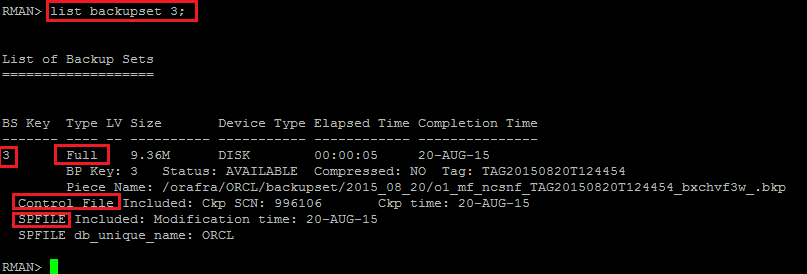
MAXSEQ is set to 255 by default, and RESTORE counts backward from MAXSEQ to find the last backup of the day.

MAXSEQ parameter to n to reduce the search time. If you know that RMAN never produces more than n autobackups each day, then you can set the RESTORE SPFILE FROM AUTOBACKUP. To restore the server parameter file to a nondefault location, specify the TO clause or TO PFILE clause on the RESTORE SPFILE command. If RMAN is not connected to a recovery catalog, then use SET DBID to set the DBID for the target database. If the most recent autobackup was not created today, then use SET UNTIL to specify the date from which to start the search. If the autobackups were not produced with the default format ( %F), then use the SET CONTROLFILE AUTOBACKUP FOR DEVICE TYPE command to specify the format in effect when the autobackup was performed. If restoring from disk, then RMAN uses the default disk channel. If restoring from tape, then use ALLOCATE CHANNEL to allocate an SBT channel manually. RMAN> restore controlfile from ‘+ORACLDG/DBACLASS/CONTROLFILE/control01.ctl’ Starting restore at 13-JAN-19using target database control file instead of recovery catalogallocated channel: ORA_DISK_1channel ORA_DISK_1: SID=2201 device type=DISK channel ORA_DISK_1: copied control file copyoutput file name=+DATA/DBACLASS/CONTROLFILE/ on the situation, you may need to execute multiple commands in the RUN command. Srvctl stop database -d DBACLASSsrvctl start database -d DBACLASS -o nomountĤ. start the database in nomount stage: 12345

SQL> alter system set control_files=’+DATA’ scope=spfile System altered.ģ.


Set the new location of controlfile: 1234 SQL> show parameter control_files NAME TYPE VALUE-– -control_files string +ORACLDG/DBACLASS/CONTROLFILE/control01.ctlĢ. Get the current control_file location 12345678 In ORACLE RAC:(Move from +ORACLDG diskgroup to +DATA diskgroup) 1. Move Controlfile To A New Location In Oracleīelow are steps to move or rename controlfile to a new location(Mount point or diskgroup).


 0 kommentar(er)
0 kommentar(er)
